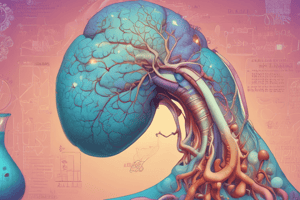Podcast
Questions and Answers
Which of the following signs or symptoms is associated with hypercalcemia?
Which of the following signs or symptoms is associated with hypercalcemia?
- Increased deep tendon reflexes
- Facial droop (correct)
- Smooth muscle spasms
- Decreased deep tendon reflexes (correct)
What is a common nursing intervention for hyponatremia?
What is a common nursing intervention for hyponatremia?
- Restrict fluid intake
- Administer diuretics
- Administer intravenous sodium chloride
- Monitor for seizures (correct)
Which of the following is a risk factor for bladder cancer?
Which of the following is a risk factor for bladder cancer?
- Menopause
- Smoking (correct)
- Prostate enlargement
- Frequent urinary tract infections
Which of the following is a common symptom of dysmenorrhea?
Which of the following is a common symptom of dysmenorrhea?
What is a common treatment for cervical cancer?
What is a common treatment for cervical cancer?
Which of the following medications is commonly used to treat BPH?
Which of the following medications is commonly used to treat BPH?
Which of the following is a common symptom of testicular cancer?
Which of the following is a common symptom of testicular cancer?
Which of the following is a risk factor for gonorrhea?
Which of the following is a risk factor for gonorrhea?
What is the normal range for serum potassium?
What is the normal range for serum potassium?
Which of the following is a manifestation of hypervolemia?
Which of the following is a manifestation of hypervolemia?
What is the normal range for PCO2?
What is the normal range for PCO2?
What is a common nursing intervention for patients with hypervolemia?
What is a common nursing intervention for patients with hypervolemia?
What is the medical management for hypovolemia?
What is the medical management for hypovolemia?
What is the normal range for HCO3?
What is the normal range for HCO3?
What is a common manifestation of hypokalemia?
What is a common manifestation of hypokalemia?
What is the medical management for hyperkalemia?
What is the medical management for hyperkalemia?
Flashcards are hidden until you start studying
Study Notes
pH and Acid-Base Balance
- pH ranges: 7.35-7.45
- pH lower than 7.35: Acidosis
- pH higher than 7.45: Alkalosis
- Pco2 ranges: 35-45
- If PCO2 is going in an opposite direction than pH, it indicates a Respiratory disorder (Respiratory acidosis)
- Respiratory acidosis: pH less than 7.35 and Pco2 higher than 45
- Respiratory Alkalosis: pH greater than 7.45 and Pco2 less than 35
HCO3 Ranges
- HCO3 ranges: 22-26
- If HCO3 is going in the same direction as pH, it indicates a Metabolic problem
- Metabolic acidosis: Decreased pH, Pco2, HCO3
- Metabolic Alkalosis: Increased pH, Pco2, HCO3
Fluid and Electrolyte Balance
- Diffusion: Fluids move from extracellular to intracellular
- Hypovolemia manifestations: Tachycardia, Tachypnea, dehydration, Low bp, Orthostatic hypotension
- Hypovolemia medical management: IV isotonic solution 9% NS
- Hypovolemia nursing interventions: Fall precaution, Assist with ambulation, Monitor weight, Skin turgor assessment
- Hypervolemia manifestations: Hypertension, Rapid peripheral pulses, Respiratory symptoms, Crackles in lungs
- Hypervolemia medical management: Fluid restriction
- Hypervolemia complications: Weight gain of 2lbs in 3 days
- Hypervolemia nursing interventions: Monitoring weight, Calculating/monitoring strict I & Os, Fall precaution
Electrolyte Imbalance
- Hypokalemia: Serum potassium level < 5.0
- Hyperkalemia manifestations: ECG changes, Tall peaked T waves, Abdominal cramps, Muscle weakness, Diarrhea, Arrhythmia
- Hyperkalemia interventions: Calcium gluconate IVP, Calcium administration, IV dextrose and insulin administration
- Hypomagnesemia level: < 1.6
- Hypomagnesemia cause: Diarrhea
- Hypomagnesemia nursing management: Referral to alcohol abstinence programs
- Calcium normal values: 8.2-10.2
- Calcium and potassium are heart sensitive
Calcium Imbalance
- Hypocalcemia manifestations: Smooth muscle spasms/twitching, Positive Trousseau and Chvostek sign
- Hypercalcemia manifestations: Decreased deep tendon reflexes
- Hypercalcemia medical management: IV biphosphates, Calcitonin
Sodium Imbalance
- Hyponatremia cause and manifestation: Diuretics and seizure
- Hyponatremia nursing interventions: Seizure precaution
- Hypernatremia medical management: Limit sodium intake, Monitor daily weight
Chloride Imbalance
- Hypochloremia manifestations: Irritability, Hypotension, Tetany (Charlie horse)
Metabolic Acidosis
- Metabolic acidosis treatment: Treat underlying cause, Antidiarrheals
- Metabolic acidosis nursing management: Decreased cardiac output related to severe metabolic state
- Metabolic acidosis nursing interventions: Monitor hemodynamic status
Urinary Tract Infections
- UTI manifestations: Dysuria (painful urination and burning), Dark foul-smelling urine
- UTI nursing intervention: Increased fluid intake 2-3 liters per day
Urinary Incontinence
- Urinary incontinence: Involuntary or uncontrolled loss of urine in any amount
Cancer and Reproductive Health
- Bladder cancer risk factor: Smoking
- Dysmenorrhea treatment: Combined oral contraceptive (Progesterone & estrogen)
- Black cohosh: Menopause
- Cervical cancer diagnosis: Routine screening (pap smear)
- Cervical cancer treatment: Colposcopy with biopsy
- BPH manifestation: Weak urine stream/decreased force
- BPH medications: Anticholinergic
- BPH diagnosis: Digital rectal exam, Urinalysis to detect infection or blood
- Prostate cancer risk factor: Prostate enlarges with age
- Prostate cancer teaching: Signs of infection/fever
- Testicular cancer normal finding: Testicles are darker in skin color than the rest of the body
- HPV increases the risk of: Cervical cancer
- HPV diagnosis: Pap test, Colposcopy
- HPV nursing intervention assessment: Presence of genital warts
- HPV teaching: Prevention vaccine recommended for age 15-26
- Genital herpes manifestations: Fever, Headache
- Genital herpes medication: Cannot be taken during pregnancy
- Chlamydia may be asymptomatic but may result in: Dysuria
- Gonorrhea risk factors: Low socioeconomic status, History of STI and PID, Multiple sex partners
- Menopause classification: 12 months of no vaginal bleeding
- Urolithiasis (kidney stone) and UTI complication: Pyelonephritis
- Turp procedure: Surgical procedure that involved cutting away a section of the prostate BPH
- Cervical dysplasia: Abnormal growth of cells on the surface of the cervix (caused by HPV)
- Condylomata Acuminate: Anogenital warts caused by HPV
- Syphilis medication: Penicillin
Studying That Suits You
Use AI to generate personalized quizzes and flashcards to suit your learning preferences.




